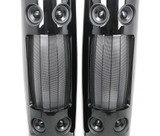The Gearhead: Sharing The Sweet Spot

To some, the Muraudio SP1 speakers recently listed in our Certified Pre-Owned catalog look like something out of a science fiction novel. To my eye, they represent some of the most forward-thinking science in high-end speakers on the market right now.
I first became aware of Canadian manufacturer Muraudio and the SP1s at Rocky Mountain Audio Fest (may it RIP) years ago and instantly recognized their iconic look when a pair arrived at The Music Room. Like Martin Logan, Muraudio melds electrostatic panels with dynamic drivers in a hybrid arrangement. Unlike the better-known American brand, the Canadians employ numerous thin panels and smaller cone drivers, which are fantastic and thoughtful elements of the overall high-performance design.
The SP1’s traditional cone drivers aren’t there merely to make bass. With four small 6” drivers for each speaker, the cone drivers can move the same amount of air as a larger driver while maintaining smaller drivers’ directivity and polar response leading up to the midrange band.

Large drivers may be great for bass, but they tend to “beam” as the frequency rises. The dispersion angle gets smaller at higher frequencies, and the eventual transition between midrange and treble becomes more complicated. Tweeters at the bottom of their response have much wider dispersion than at the top, and it’s the same with cone drivers. So in traditional setups, the handoff between midrange and treble suffers an abrupt change in dispersion. This leads many speaker manufacturers to incorporate “waveguides” on the tweeter to lend a hand with this transition.
Not necessary with the SP1, which is very cleverly designed for maximum driver cohesion. The four cone drivers per cabinet pull off the bass response and can resist beaming at higher midbass frequencies. The handoff at 750Hz to the array of thin electrostatic panels means the directivity of both types of drivers is well-matched and seamless. And the use of the large electrostatic panels only for mid and treble increases their effectiveness in those regions compared to a typical full-range panel.
Let’s talk about the electrostatic element. Speakers with large panel- or ribbon-based midrange drivers have many strengths, especially when used the way Muraudio uses them as they do in a curvilinear array.
Using a large, essentially weightless membrane for the critical midrange and high frequencies results in zero momentum or “overhang” often experienced with cone-based midranges and tweeters. This increases resolution at the critical frequencies which are most important for replicating the sense of space in a recording.
The lack of dispersion transition and the way they are arranged in a shallow semicircle toward the listening space makes this spectrum region incredibly resolving and much less directional and allows the sweet spot for these speakers to be huge.
That’s why all of the reviews you see for the SP1s have to mention the fact that “there’s no bad seat in the house” when listening. Roger Sanders’ invention of the curvilinear electrostatic panel is represented here to a degree, as is Soundlab’s method of segmenting portions of that panel for clarity and cohesion at each listening spot. There are also echoes of the “Radialstrahler” design from Germany’s MBL in the arrangement.
The SP1 employs some of the best ideas from many previous approaches in speaker design, and it’s no wonder Muraudio has hauled in a hefty stack of awards in the SP1’s few short years in existence.
If you want to taste the state-of-art in HiFi speaker design while spreading the fun to whoever is lucky enough to have a seat in the room, these are your speakers. Pair them with nimble audiophile subs like REL S/812 or Carbon Special, and you’ve got a top to bottom full-range display with zero limitations -- least of all a "head in the vise" sweet spot. These are special speakers, to be sure.

